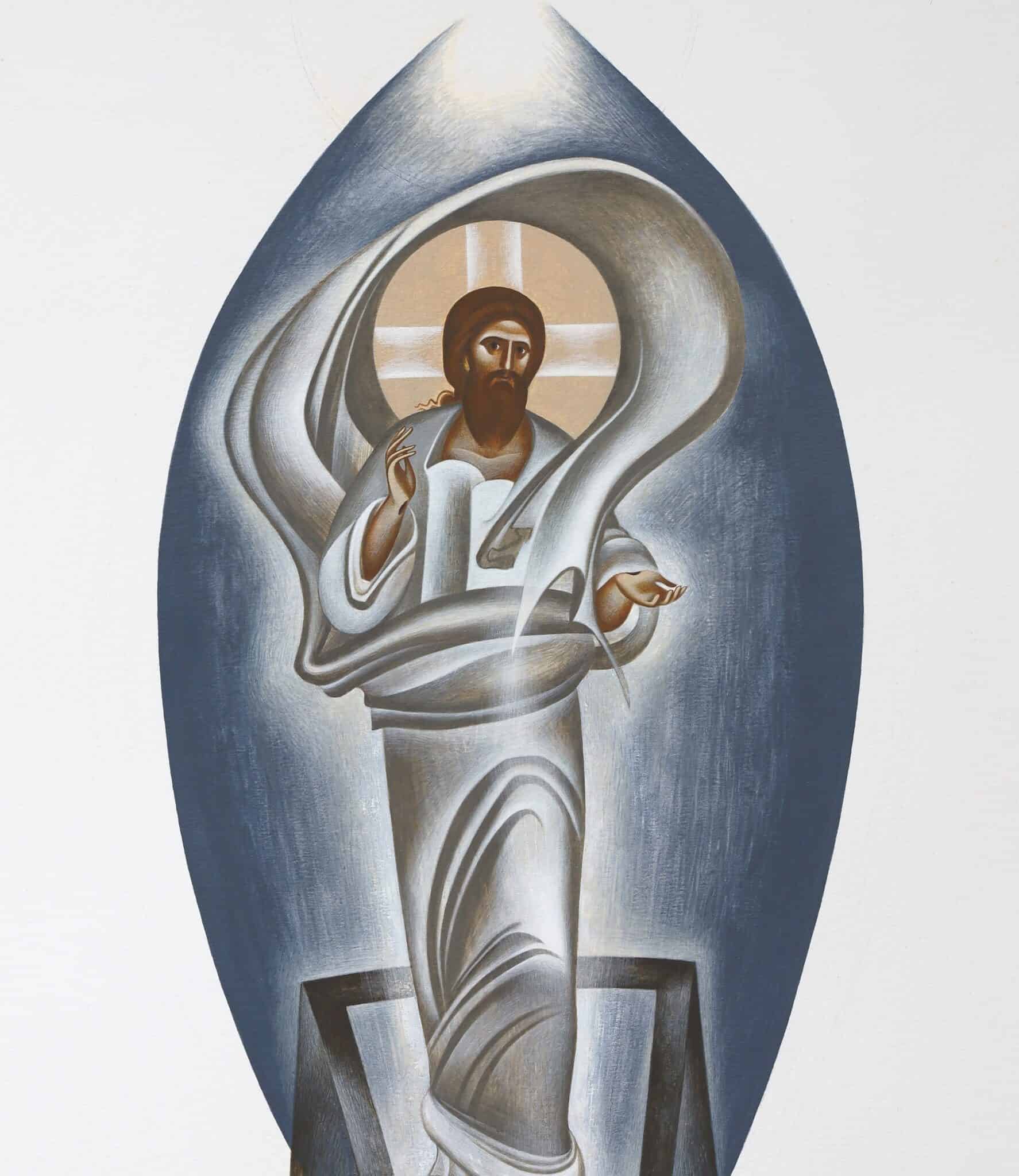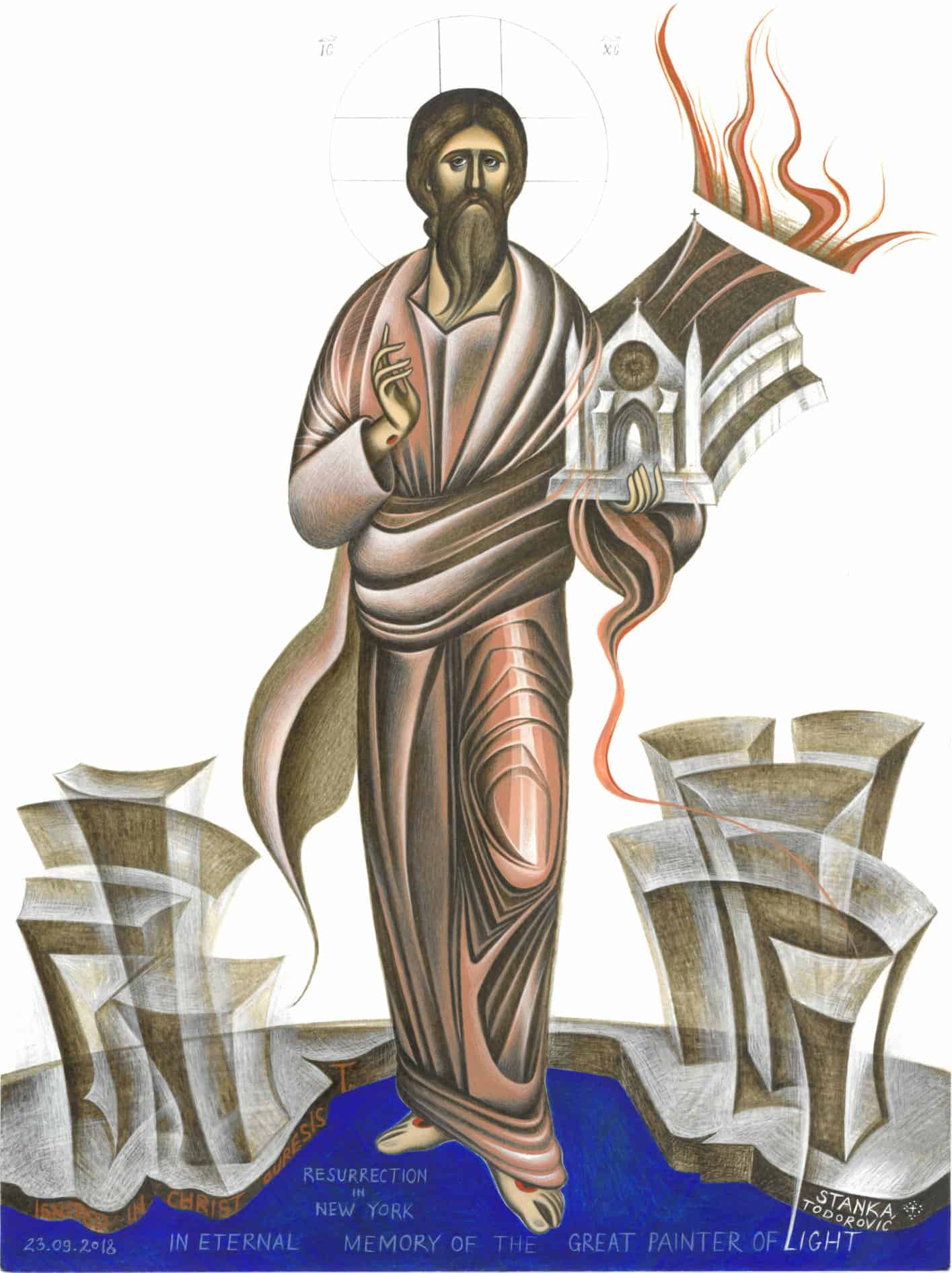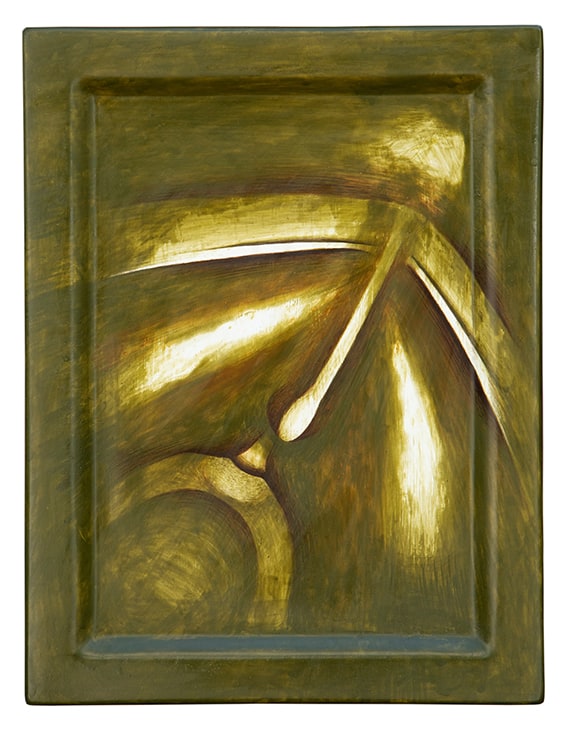by Dr Vassilis Adrahtas greek city times
Todorovic virtually grew up in an art studio and has been involved in painting, sculpture, and iconography for more than two and a half decades. He regards himself as Greek – in fact he became a Greek citizen quite recently – and works consistently in what I would call the ‘ecumenical Greek vision’. In other words, he is firmly placed in the age-long Greek art tradition, utilising influences from multiple cultures and transforming motifs so that they appeal to a global post/modern audience.
Chronokrator
The flow of History (in the background) and the ever-present Person (in the foreground); Time, with all its decay (signified by the intentional tampering of the composition), and Eternity, defying and relentless (through the Beloved Gaze); the messianic Eschaton here and now – radiant in the blue hues of its Glory! This seems to be the conceptual imagining of Chronokrator by Serbian-born Ouresis Todorovic. In other words, the painting constitutes a modern adaptation/reinvention of the traditional Pantokrator theme, well-known in the domes of Orthodox Churches. However, Todorovic insightfully and skilfully shifts the focus from spatiality, i.e., the cosmic, to temporality, that is, the distinctively human – and humane. Consequently, the figure of Christ is depicted not so much as the Theanthropos as the archetypal, the one and only, the true and perfect Anthropos. The traditional abstraction of the theme is preserved, with one slight but crucial difference: movement or, better, the tension between the moving and the unmovable. In this respect, regardless of everything turning away, the El Shaddai Messiah is coming – closer and closer – towards our direction! Moreover, there is a dream-like character to the whole painting that resonates with the emotionality of many an art tradition around the globe.

Anastasis
Is it a tomb becoming empty, or a room being filled? Is it about the Lord coming or going, ascending or descending? In this Anastasis by Todorovic we can be sure of one thing: Divine Motion. But what is the conceptual aesthetics of this ‘motion’? The artist is undoubtedly pointing to the traditional theology of Christ’s Life-Giving Death, His Death-as-Life. Of course, one could say that this could have been better represented with the depiction of Christ’s Crucifixion, but one should always keep in mind that it is only in the light of His Resurrection that the faithful realise what His Crucifixion has been all about. In any case, Todorovic is once again reinventing a traditional theme: the universal impact of Christ’s rising from the dead. There are still two levels in the painting but it’s not anymore – at least, not so much – about life and death as it is about presence and absence. To be sure, the composition recalls Christ’s descent into Hell, but this is a Hell devoid of the specificity of a vulnerable humanity; it is the Hell of history, where the human condition has become one with emptiness. It is this emptiness that the artist intends to erase and at the same time accentuate through the dialectics of the Resurrected Christ’s presence and absence – a dialectics full of hope.

Resurrection in New York
Another Anastasis, this time in New York, a quite emblematic work by Todorovic and very dear to him for personal reasons, since it is dedicated to and reminiscent of his mother, the late Stanka Todorovic – ‘the great painter of light’ as he describes her. In the guise of a super-human figure, the Resurrected Christ oversees the world, which in turn is represented in the guise of the most secular city ever, New York. The secularity of the city and, by extension, of the whole world is visually captured in the abstract form of the skyscrapers and juxtaposed to the Church, which although ‘bone of [their] bones and flesh of [their] flesh’, has a personality and a face, so to speak. In other words, the Church is the world taken on by the Logos and divinised by the flame-like energies of His Spirit. But, apart from the fire-red garments, the sacred is also represented in the midst of the secular by the deep blue waters; the waters of regeneration and cleansing. Although imposing, Christ is not intrusive, but like a humble deacon holds the Church in an all-caring manner. Due to the spatiality implied, the painting reflects a quite cosmopolitan perspective, one that indeed fuses the historical and the cosmic into an integral eschatological reality.

Platytera
Deep blue reigns supreme! Pure space, pure form! Everything in nothingness! The Platytera by Todorovic is surely an exercise in abstract Orthodox iconography and an experiment in the use of a monochromatic colour scheme. The background or the matrix, if you prefer, from which everything emerges is ‘theios gnofos’, that is, the overwhelming Light of Divinity that turns into a blinding manifestation. But eventually there is a revelation! The revelation of a spiritual body, the body of Mother and Child, the Theotokos and the Messiah-God. The Chalcedonian doctrine of the perichoresis – for everything in this painting is in a circular mode – between the Divine and the Human constitutes a tour de force of representation. In particular, the Divine takes on the contours and shape of Humanity, while Humanity finds its proper place within the embrace of Divinity. Once again, Todorovic conceives of his theme in terms of a dialectical aesthetics whereby the layers of presence and absence, uncreated and created, are in a constant interplay. The increasing/decreasing intensity of light creates a sense of presence (through the triple ‘cloud of unknowing’ or shekinah) for the absent Divine and also an imagining of absence (through transparency) for the present human hypostases. Yet, in this luminous vision of Divine-Human union the red cross within the halo of Jesus points to the passion in the heart of God...

Cosmic Christ/Suffering Logos
This is as abstract as it gets in the aesthetic universe of Todorovic’s Orthodox iconography. Just a face, just a shapeless form, just the poiesis of light! But how do you paint the face of God? The answer is simple, yet at the same time tricky: in the way, of course, that He has revealed Himself! But what way is that? Todorovic works again through his cherished dialectics of presence and absence, veiling and unveiling, so as to suggest the fusion of the historical and the cosmic. What we see in Cosmic Christ/Suffering Logos is undoubtedly the face of Jesus, the presentation of a historical figure, but at once it is an image of cosmic proportions, of light radiating throughout some galaxy of the universe. If the Psalmist is right and ‘the heavens [do] declare the glory of God’, Todorovic then has been duly inspired to depict the natural contemplation of the Son of God, the Uncreated Creator of the cosmos. This is a contemplation of serenity, acceptance and apokatastasis, but one cannot fail to perceive the tension, the pain and the cost that has come along with it – the cost God must pay for freely creating free beings, the cost of denial. Ultimately, the face of God is the face of each and every one of us, a truly global face!
As one can easily attest, the Orthodox iconography of Todorovic is indeed a theology in colours. Moreover, one of its most distinctive features consists in the sculpture qualities that it encompasses; qualities that provide motion to the motionless. The abstract character of his paintings/icons is very conspicuous as well, spiritualising the cosmic and the material. This kind of spiritualising abstractness renders historicity into a topology that is nowhere and everywhere, never and everywhen. In a nutshell, I would dare say that Todorovic is in the process of creating for the Orthodox Christian experience an aesthetics of global esotericism.
ABOUT | Dr Vassilis Adrahtas
Dr Vassilis Adrahtas holds a PhD in Studies in Religion (USyd) and a PhD in the Sociology of Religion (Panteion). He has taught at several universities in Australia and overseas. Since 2015 he has been teaching ancient Greek Religion and Myth at the University of New South Wales and Islamic Studies at Western Sydney University. He has published ten books. He has extensive experience in the print media as editor-in-chief, and columnist, and for a while he worked as a radio producer. He lives in Sydney, Australia, his birthplace.
Dr Adrahtas writes the weekly column "Insights into Global Orthodoxy" published every Sunday by Greek City Times.


Δεν υπάρχουν σχόλια:
Δημοσίευση σχολίου
Σημείωση: Μόνο ένα μέλος αυτού του ιστολογίου μπορεί να αναρτήσει σχόλιο.